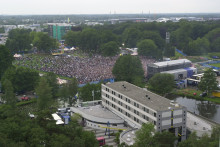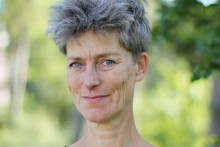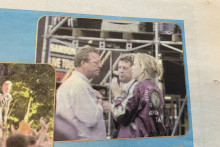Firstly, the raw, hard facts about the Fireworks Disaster: on 13 May 2000, the biggest explosion of the Netherlands since the Second World War takes place. A fireworks storage of the Enschede company S.E. Fireworks catches fire and explodes. 23 people die, about 950 are wounded, and 200 houses are fully destroyed.
Around two hundred UT employees and about 175 students live in the Roombeek neighbourhood and its surroundings. Seventeen UT employees and more than fifty students lose everything they own.
At least two students are injured in such a way that they need to go to the hospital. One freelancer, commissioned by the university’s occupational health and safety department, loses their life.
Student home ‘De Kadullen’, of Christian student association Alpha, is right across S.E. Fireworks. The 49 Tollensstraat home is completely flattened by the blast. Inhabitants are UT students Wim van Hoeve, Remco Dijkman ad Claas-Willem Visser. The three students aren’t home at that moment. ‘We’re alive’, they’ll later say in an interview with UT Nieuws, U-Today’s predecessor. ‘That’s what matters, the rest is unimportant. Possessions are simply possessions.’
UT provides help that Saturday evening, 13 May. Catering employees, for example, make packed lunches for the emergency workers late into the night.
Victims are being cared for in the Drienerburght and in the log cabins on campus. In addition, campus residents spontaneously offer accommodation. Accommodation Logica is also designated as a reception location.
A key role is played by student housing provider SSHD – the Drienerlo Student Housing Foundation. It provides shelter to at least forty victims, both in the city and on campus. They also receive canteen vouchers and money to meet basic needs.
UT associations take action; Isaac Newton's mechanical engineers form a handyman team, orchestra SHOT organises a benefit concert, the fruit and packed lunches intended for Aloha’s now-cancelled UT Triathlon go to victims housed in the Diekmanhallen, the proceeds of a study week of Stress go to disaster fund giro 777. The rowers of DRV Euros also set up a spontaneous fundraiser: they have their heads shaved by campus hairdresser De Barreboks to raise money.

The Associations of the Pakkerij also express their condolences to the victims. On Thursday 18 May, each association will observe a minute of silence at midnight. The associations also offer shelter and raise money for the victims in their own ways.
Danny de Vries, a student of communication science at the time, becomes world famous for being the first to share film images of the fireworks disaster. How he experienced the disaster, and about the world we live in now, he shares in a book called 'Letter to Marcel' in 2020. In 2018, De Vries is appointed Knight in the Order of Orange-Nassau for his role in the fireworks disaster, his commitment to Twente, the Royal Family, and LGBTIQ+ emancipation. Nowadays, De Vries is mayor of the municipality of Oudewater.

From Wednesday 31 May 2000, the UT's Student Psychologists Office starts a 'peer group', intended for students who want to talk about what they experienced during the disaster. And there are more opportunities to talk, including at a meeting of the Executive Board and the student chaplaincy. Student chaplain Kees Kuyvenhoven also sets up self-help groups.
UT also offers its knowledge, writes UT Nieuws in the newspaper that is published on 25 May 2000. This concerns the settlement of the fireworks disaster and the reconstruction of Roombeek (more on this later). Students also fulfil a role. The Department of Chemical Engineering is investigating a piece of rock that was released in the disaster for precipitated substances.
The then UT Nieuws releases an interview with Ron da Costa, former electrical engineering student and the man behind fireworks shows during the Batavierenrace and the New Year's Eve party in the Bastille. According to him, it is impossible to achieve a mass explosion like the fireworks disaster in Roombeek with fireworks alone. 'Something else must have been stored there.'
In any case, speculation runs rampant soon after the disaster: how could this happen? UT Nieuws asks an in-house expert who teaches safety and risk management at UT. He suspects that S.E. Fireworks never calculated the dangers to the immediate environment. This leads to an angry letter from a UT professor of safety science, who points out outdated safety standards mentioned in the article to the editor and expert and writes: 'UT Nieuws now sounds like yet another bell without a clapper'. UT Nieuws, in turn, parries that the 'reporting was very careful'.
Soon after the disaster, a benefit concert is announced. Initially, the concert is to be held in the Arke Stadium of FC Twente, but due to permit problems, the event is moved to the UT campus.

Artists are well-known Dutch artists like Marco Borsato, Volumia, Abel, Skik, Bløf, Van Dik Hout, City to City, Kane, Buffoons, Gerda Havertong, Total Touch, Dutch Diva, and Ernst Daniël Smit. The concert lasts five hours.
The benefit concert on 14 June 2000 at the UT attracts more than 25 thousand visitors. Tickets cost 35 guilders at the time, which converts to 15.88 euros.
An fundraiser among staff members, in which they give up a day off, yields 2.5 tons. The Executive Board will double this amount, rector Frans van Vught announced at the opening of the concert.
Coordinator of the benefit concert is UT event manager Tonnie Buitink. In his farewell interview in 2024, he talks about the UT's involvement in the aftermath of the disaster: 'Our motorcycle group took people from the disaster area and brought them to the UT grounds. On the lawn near the Carillon, they were accommodated in a white tent. I coordinated that and later got a ribbon for it.'

In March 2002 it was announced that the benefit concert for the victims of the fireworks disaster raised 837,980 euros for the Fireworks Disaster Foundation. The announcement of the proceeds takes almost a year and a half. According to UT employee Jan Melief, chairman of the Benefit Concert Foundation, extensive account checks were necessary.
After the disaster, UT scientists and public administration experts Bas Denters, Pieter-Jan Klok, and Oscar van Heffen conduct research into citizen participation in the reconstruction of the Roombeek district. The main lesson that emeritus professor Denters learns, he says in his farewell interview: 'Take people seriously, listen to what they want and what they see as their problems themselves and how they want to solve them. That is the beginning of a crucial dialogue.'
Ten years after the disaster, UT Nieuws looks back with those affected and those involved, in a special edition of the newspaper. The headlines in the interviews are telling: 'We now draw a line under it', 'The glazier never came', 'My head stopped working’ and 'Images of other disasters now make more of an impression'.
Commissioned by the House of Representatives, the UT Department of Public Administration conducts an independent inquiry in 2023 into the Enschede fireworks disaster and the fireworks disaster in Culemborg (1991). The central question is how the government can better learn lessons from similar disasters. René Torenvlied, Simon Couwenberg, and Michiel Heldeweg are conducting the research on behalf of the UT, together with Matthijs Moorkamp (Radboud University).
In December 2023, the research team submits the study 'Learning from two fireworks disasters' to the House of Representatives. The team goes through 250,000 pages, which leads to solid conclusions about, among other things, the storage of fireworks, extinguishing instructions for the fire brigade, and the supervision of the fireworks industry. For example, 'lightly' classified fireworks in the event of a fire turn out to be much more dangerous than previously thought.
Bonita Avenue, by author and former UT Nieuws editor Peter Buwalda, is set against the backdrop of the fireworks disaster. From the moment of the blast, tensions within the family of the book’s main characters also explode.
In May 2024, it is announced that the Safety Council (staffed by chairmen of the 25 security regions in the Netherlands) want to get rid of fireworks storage in residential areas. The decision is taken on the basis of UT professor René Torenvlied’s research, which concludes that consumer fireworks can cause a mass explosion in the event of a fire.





